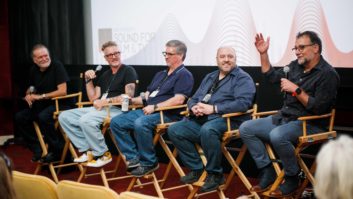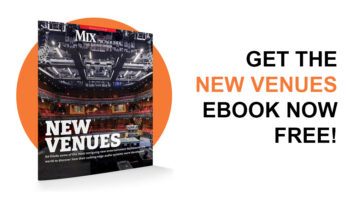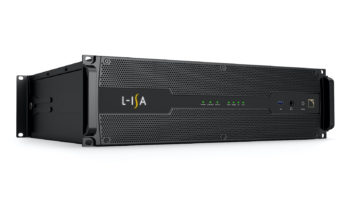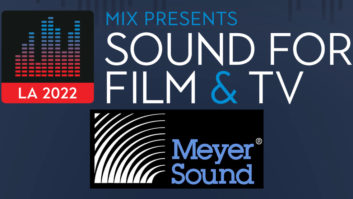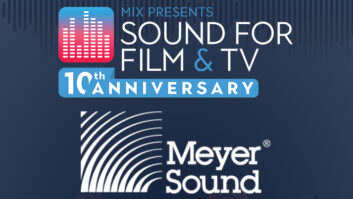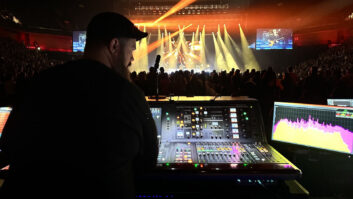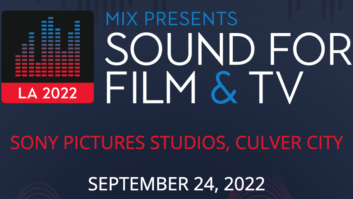Since its birth more than 100 years ago, the audio industry has always been a multifaceted field, serving diverse areas such as prerecorded music, broadcast, film, sound reinforcement and telephony. But while these applications all have sound in common, they have traditionally operated as separate disciplines-each aware of but not entirely integrated with the others. In recent years, however, rapid technological changes have been pushing these industries toward convergence, while new applications for audio have emerged in interactive gaming and the Internet. It all adds up to new opportunities for both experienced and aspiring audio professionals. But it also contributes to the challenge of keeping up with the field at a time when versatility is an increasingly important requirement for success.
“It’s very difficult now for a working professional to know everything there is to know,” says Gary Platt, founder and president of Ex’pression Center for New Media in Emeryville, Calif. Opened in January 1999, the Center’s self-described “prime objective” is to “provide an excellent, comprehensive education to students who want a career in the world of digital visual media and sound arts.” That means Platt is responsible for ensuring not only that Ex’pression’s audio graduates have studio chops, but also that they have a broad understanding of the constantly evolving applications for audio in today’s production environment.
Ex’pression is the outgrowth of a chance 1997 meeting between Platt and Eckart Wintzen, Dutch founder of BSO/Origin, an international software services firm. Formerly senior VP and director of education at Full Sail in Winter Park, Fla., Platt was eager to explore new approaches to training media production professionals, and Wintzen shared his enthusiasm. The two subsequently brought in Peter Laanen as CEO, and ultimately settled on Emeryville (across the Bay from San Francisco) because it is, in Platt’s words, at a “crossroads between the movie and music industries on the one hand and Silicon Valley-the ‘dot.coms’ and the software industry-on the other.” The school offers students two main paths, each with its own director: Duke Zaffery for Sound Arts and Rob Gibson for Digital Visual Media.
TURNKEY GRADUATES”Our mission is to turn out the ‘turnkey’ graduate for our industry,” Platt says. “Help is easy to find, but good help is not. Many times you hear employers say, ‘Once we get ’em out of school, we retrain ’em.’ That’s bizarre to me. We put in a ton of effort to mold our students so that employers won’t have to spend money and time on ‘retraining.'”
Part of the effort that Ex’pression puts in, Platt says, is directed not simply at developing technical skills, but at other ingredients that make a good employee. “We do attitude adjustment here: ‘Don’t come to school with a cloud over your head because negative attitudes are not accepted.’ That’s harder for some students to accept than others. But if we don’t teach attitude, the failure rate would be high no matter what the graduates know technically.”
The bulk of the teaching, however, is focused on production skills, and as the “New Media” in the center’s name suggests, the program addresses not just the recording industry but a wide range of audio and visual applications. To Platt, that’s a natural reflection of changing times. “There are a lot of gigs out there,” he continues, “but in a variety of fields. So it’s not about the record/music business as much as it is about having skills in more areas. The new-millennium sound engineer might mix live sound one day, a commercial the next, post a video, teach and then go home and make sound for a Web site. I think if all you want to do is make records, it’s probably tougher than it used to be. But if you like variety, it’s the best!”
As for future prospects for audio professionals, Platt is unabashedly bullish. “There will be more opportunity,” he says, “with more video/film posting than ever. Plus, gaming is huge, and as the delivery systems improve, we’ll see more Web ‘sonification.’ Meanwhile, DVD-Video and HDTV utilize 5.1 channel sound, and we’re seeing more and more engineers working in that arena. And if we stop this foolish behavior of watermarking and DVD-Audio ever gets to the marketplace, I think that will usher in a new era of music-for-pleasure mixing in 5.1.”
REVERSE ENGINEERINGSo how does Ex’pression go about preparing its students for Platt’s anticipated era of audio abundance? Platt refers to the school’s overall method as total immersion, based on the idea of emulating the real working environment of “the latest creative technology industries.” Describing the approach as very intense, he says, it is “not for everyone. It is very hard mentally, emotionally and physically.”
According to Zaffery, the school’s Comprehensive Sound Arts Program was developed with lots of input from prospective employers. “We sort of ‘reverse engineered’ the curriculum,” he says, “by asking our industry what skills would make our entry-level graduates valuable.”
The result is a blend, combining a study of the fundamentals with hands-on experience. The required courses cover applied skills such as recording and production, digital audio workstations, sound and lighting, MIDI, studio maintenance and even DVD authoring. But the mandatory studios also include background in areas such as architecture and acoustics, business of media, history of music production and music theory.
“Our class-to-lab balance is approximately 33 percent theory and 66 percent hands-on training,” Zaffery says. The nature of the hands-on training varies depending on the material being covered. “Full Sail teaches labs in a ‘team’ only,” Platt says. “We think students learn better when you use both individual and team instruction, each when it’s most appropriate.”
Class and lab time for the Sound Arts program adds up to 2,160 hours. Upon completion, students are expected to show competency in recording and production, audio post-production techniques for film and television, sound reinforcement and lighting, and DVD authoring. “Each student must be able to demonstrate a level of competency to our satisfaction before they can move to the next course,” Zaffery says. “No student can pass with a grade average lower than a ‘C.’ However, if [their] attendance is above 90 percent, we allow them to retake the course without charge.” The program is licensed by the state of California.
One of the challenges in developing the program was to fit in areas that didn’t even exist a decade ago without slighting the basics. For example, Platt says Ex’pression is “big into 5.1 mixing. We have ten 5.1 control rooms, and our Meyer Sound Labs Hall has a 5.1 theater/concert system with a large Crest V-12 board.” Zaffery points to other new audio applications incorporated into the curriculum, such as DVD authoring, digital mixing systems and Web sonification. “But you still have to know how to align a tape machine,” he says. “So it’s sort of a balancing act.”
Platt adds another challenge: keeping the program current in a fast-moving field. “Staying on the ‘bleeding edge’ is sometimes a weird place to be,” he says, “because we have to keep our ears wide open and use our intuition and experience to guide us. It’s not easy. Just about every month our curriculum is altered slightly in some way. We add this and shave that if it’s not as relevant.” The school also keeps students apprised of real-world developments by augmenting the regular teaching staff with additional working professionals, who come in as guest lecturers. And students get a further taste of life in the trenches through the program’s internship requirements.
EQUIPMENT AND FACILITYBeyond keeping curriculum up to date, Ex’pression faces the additional challenge-shared by commercial facilities-of keeping the equipment current. Platt’s approach has been to develop relationships with equipment manufacturers, who, no doubt, hope that today’s students will be tomorrow’s customers. In many cases specific rooms in the facility are named after particular manufacturers.
“We approach manufacturers when we have decided that a certain technology needs to be in our curriculum and facility,” Platt explains. “Some are interested to the point of placing equipment, and others give us really great deals so our students get the opportunity to experience their gear.
“If the relationship feels good, we offer to put their moniker on the individual studios. Tascam, Harman/Studer Digital, Meyer Sound, Intergraph and SGI have rooms named after them. But we also have wonderful relationships with Roland, TC Electronic/Tube-Tech, JBL, dbx, BSS, Lexicon, Crest Audio, Neumann, AKG, Shure,
Audio-Technica, Beatnik, Digidesign, WaveFrame, Sonic Solutions and Dolby.”In some cases, the relationships with manufacturers have allowed Ex’pression to bring on line facilities that might not otherwise have been feasible. Platt seems particularly excited, for instance, by the Tascam heptagon studio. “It’s six identical 5.1-channel digital multitrack control rooms arrayed around a central 1,500-square-foot studio,” he explains. “Each individual student can have their own control room in a lab. The large studio allows the students to record the same artist simultaneously and compare their recordings in class.”
“That lab is a dream that Gary Platt and I have had for years,” says facility designer John Storyk. “In addition to the studio and control rooms, add an ISO/drum booth, create a design that provides a minimum of STC 48 isolation between all rooms, create a floor plan that allows every control room to see no less than 80 percent of the studio and you have the Tascam teaching lab.”
The Tascam facility represents a microcosm of the challenges faced by Storyk in maintaining isolation while filling the school with studios, control rooms and adjacent classrooms. “By far the most difficult challenge of the design,” he says, “was packing the studios close, both for space-planning efficiency and viewing proximity. Ex’pression has over 42,000 square feet of classrooms, which are all 5.1- and video projection-capable. For circulation isolation, they had to be in separate areas of the building, yet we all felt a need for all parts of daily student life to be connected. So all recording facilities have numerous glass viewing windows, allowing visitors and students to view all studio session work but still permitting complete studio isolation. This was accomplished with a complex system of block walls, split poured concrete slabs, and isolated frame and spring ceilings.”
Another major consideration for Storyk that separated Ex’pression from non-educational projects was the need for flexibility. “Current marketplace production facilities most typically respond to one or two very specific commercial media-creating needs,” he says. “Even the more general-purpose types of facilities, such as music recording studios, are typically built to respond to a particular type of music and market requirement. But at Ex’pression, the audio and digital media facilities provide students with as many possible recording and production experiences as possible. There are six distinct audio recording and production environments, each with its own set of acoustic and equipment characteristics.”
FROM SCHOOL TO WORKThe ultimate measure of a professional training program is, of course, the extent to which its graduates find success in the real world beyond the school grounds. Ex’pression is too new to have any meaningful track record in this regard, but based on the response he has gotten so far, Platt is optimistic. “We have a really good placement department for internships and jobs that graduates of Ex’pression can access for life,” he says. “And there seems to be a special interest in our graduates. We have employers ringing our phones off the hook looking for quality employees. I think some facility managers are thinking, ‘Let me test-drive one of these Ex’pression grads and see how they perform.’ That’s exciting to me, and I’m anxious to get our grads out on the track.”
Still, Platt realizes that for Ex’pression students the training program is really only the start of the process of achieving and maintaining success. Given the uncertainties that come along with the new opportunities he sees in audio, he points out, “The days of going to work at the same place all the time just don’t exist like they used to. So career security can only be achieved by the individual. The opportunities are there for the picking, but you’ve got to actually pick them-they won’t just fall off of the tree. You must keep learning new skills because your value is only the value you make it.”

